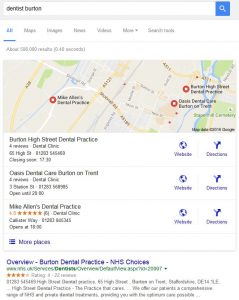Mobile-optimised dental newsletters
Is your e-newsletter system working correctly for viewing on mobile?
 The need for mobile-optimised or “responsive” websites is well-understood and now widely adopted by the majority of dental practices who are serious about their web presence. For those who are still lagging behind, the disadvantages of providing poor user experience and lower Google ranking are very real.
The need for mobile-optimised or “responsive” websites is well-understood and now widely adopted by the majority of dental practices who are serious about their web presence. For those who are still lagging behind, the disadvantages of providing poor user experience and lower Google ranking are very real.
However, far less has been said about other web systems which also need to be re-configured to embrace the mobile revolution. In particular, e-newsletters which are used by many practices to broadcast regular e-news updates to their patients.
Dental e-newsletters
Elsewhere in this blog we’ve discussed the many benefits of establishing an email list of patient (and prospective patient) contacts and using this to send out news updates and offers on a reasonably regular basis. Done well, this is a great way to keep your business in the forefront of patients minds, particularly in an environment where they are already likely being bombarded with promotional material from your nearby competitors. There are a number of good systems available; some like the excellent MailChimp are free, which enable you to compile a newsletter via a web-based system and easily send it out to to your full email list or targeted segments of the list if preferred.
Why mobile-optimised?

 This may sound rather an odd topic but what I hope to illustrate quickly in this article, is that you really must consider patient acquisition from the web when deciding where to build, or buy, a dental practice. The key factors to consider are Google local search and also the level of existing competition in the main search index. These two elements alone can have a huge bearing on how easy, or difficult, you will find it to acquire new patients who are searching on the web for dental services.
This may sound rather an odd topic but what I hope to illustrate quickly in this article, is that you really must consider patient acquisition from the web when deciding where to build, or buy, a dental practice. The key factors to consider are Google local search and also the level of existing competition in the main search index. These two elements alone can have a huge bearing on how easy, or difficult, you will find it to acquire new patients who are searching on the web for dental services. Elsewhere in the Dental Media blog we’ve discussed the pros and cons of content management systems (CMS) and whether or not you need to implement one for your practice website. On the upside they can be useful for making minor changes to text but on the downside, for anything more detailed you will likely need the assistance of your web designer. There are also the security and maintenance issues to understand. But with these limitations understood, you should be able to make an informed choice about whether or not you want to use a CMS.
Elsewhere in the Dental Media blog we’ve discussed the pros and cons of content management systems (CMS) and whether or not you need to implement one for your practice website. On the upside they can be useful for making minor changes to text but on the downside, for anything more detailed you will likely need the assistance of your web designer. There are also the security and maintenance issues to understand. But with these limitations understood, you should be able to make an informed choice about whether or not you want to use a CMS. It won’t come as much of a surprise that, when consumers are shopping for products and services, including dentistry, they are attracted to websites which use high-quality, engaging imagery more-so than sites which are text heavy with few, low quality photographs.
It won’t come as much of a surprise that, when consumers are shopping for products and services, including dentistry, they are attracted to websites which use high-quality, engaging imagery more-so than sites which are text heavy with few, low quality photographs. A good quality website should serve you well for several years, but you should still expect to make periodic updates to an existing design and then carry out a more extensive, structural update every 3 or 4 years. In this blog we take a look at why this is and why you simply can’t leave your website untouched in the hope that it will continue to perform optimally.
A good quality website should serve you well for several years, but you should still expect to make periodic updates to an existing design and then carry out a more extensive, structural update every 3 or 4 years. In this blog we take a look at why this is and why you simply can’t leave your website untouched in the hope that it will continue to perform optimally. Here at Dental Media we have a reputation for transparency and flexibility and we strive to work with clients to deliver the most cost-effective and professional solutions in line with their budget.
Here at Dental Media we have a reputation for transparency and flexibility and we strive to work with clients to deliver the most cost-effective and professional solutions in line with their budget. There is an apparent trend at the moment for dental practices to try out Facebook marketing, perhaps on recommendation from their marketing company, business coach or from what they’ve read in the media. Many practices are also trying it under their own steam in true ‘DIY’ style. But is Facebook marketing really the route to lots of valuable new patient enquiries or are there some pitfalls along the way?
There is an apparent trend at the moment for dental practices to try out Facebook marketing, perhaps on recommendation from their marketing company, business coach or from what they’ve read in the media. Many practices are also trying it under their own steam in true ‘DIY’ style. But is Facebook marketing really the route to lots of valuable new patient enquiries or are there some pitfalls along the way? With all of the pressures of modern practice; increasing competition, burdensome legislation and more, it’s easy to lose sight of the importance of a well-thought out and carefully managed marketing campaign.
With all of the pressures of modern practice; increasing competition, burdensome legislation and more, it’s easy to lose sight of the importance of a well-thought out and carefully managed marketing campaign. To the layperson who has limited or no exposure to search engine optimisation and how Google works, this may sound both a little bizarre and perhaps quite worrying too. What has a “penguin” got to do with a
To the layperson who has limited or no exposure to search engine optimisation and how Google works, this may sound both a little bizarre and perhaps quite worrying too. What has a “penguin” got to do with a